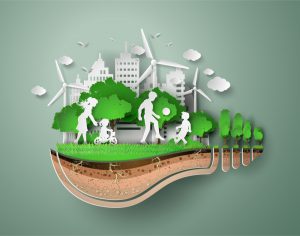By Erica Rascón on November 26, 2018 in Energy News
The recently released UN Intergovernmental Panel on Climate Change report shocked everyone who was paying attention. In short, attempting to mitigate temperature rises to 1.5 percent by 2050 (which already seemed impossible to most) is too l ittle too late. The globe is on a trajectory to see temperatures rise more than 3 percent by that time. The resulting flooding, droughts and superstorms will be catastrophic. A drastic shift in energy sourcing and usage is necessary to limit economic and humanitarian costs.
ittle too late. The globe is on a trajectory to see temperatures rise more than 3 percent by that time. The resulting flooding, droughts and superstorms will be catastrophic. A drastic shift in energy sourcing and usage is necessary to limit economic and humanitarian costs.
Fortunately, drastic doesn’t mean impossible. Microgrids and carbon dioxide recycling are two available solutions that can make substantial impact.
Microgrids
Microgrids enable centralized power generation, storage and delivery. They offer more efficient power transmission, reduce costs for consumers, and decrease the duration of blackouts which can save lives and protect economies.
A microgrid can “cut air pollution from the electric utility sector as much as 30 percent by 2030, saving 34,000 deaths a year,” states Smart Energy Consumer Collaborative.
The systems offer more immediate benefits as well. Hurricanes Florence and Michael, for example, resulted in nearly $100 billion in property damages. After factoring in electricity outages and stalled commerce, Accenture estimates that such storms can cost economies $150 billion per year. The implementation of microgrids would reduce the economic impact of natural disasters by quickly restoring power.
Microgrids also facilitate the integration of renewable energy sources with flexible scalability. Local organizations do not need to wait on utility companies or governments to implement more sustainable practices. Solar panels, roof-mounted wind turbines, and other sustainable energy devices can be used as the primary energy source on individual projects.
Several power companies are exploring the power, efficiency and reliability of microgrids. Edison International, Central Hudson Gas & Electric, Duke Energy, San Diego Gas & Electric are just a few organizations that are creating infrastructure for centralized power operations.
Larger entities have begun to see the benefits of localized power. Microgrids in Borrego Springs and Washington, D.C. demonstrate the scalability of centralized power. New York, Connecticut, Massachusetts, New York, Rhode Island, Maryland, and New Jersey all have microgrid incentives in place.
The ROI on microgrids is one factor of their growing popularity. Galvin Electricity Initiative reports that every dollar invested brings a return of as much as $5 in electricity savings, improved productivity, and job growth.
Carbon Dioxide Recycling
Microgrids are just one method of cutting costs and decreasing emissions, thus slowly saving the world. Recycling carbon dioxide is another.
In many commercial settings, analysts estimate that the cost of power is 70 percent of the cost of production. By lowering the cost of power and its emissions, companies can also decrease the cost of production and its impact on the environment.
Limiting carbon dioxide emissions is the greatest first step. For unavoidable emissions, putting the carbon dioxide to better use comes next.
Carbon Recycling International (CRI) of Iceland uses carbon dioxide emissions from local geothermal plants to produce methanol fuel. The fuel is then sold throughout Europe. Net emissions are lowered by recycling the carbon dioxide into another product. The CRI method proves advantageous anywhere with a source of carbon dioxide and power with rates around $31.50/MWh or cheaper, per analyst Robert Rapier.
The methanol product, marketed as Vulcanol, is a fuel for internal combustion engines. Methanol burns cleaner than gasoline and has a lower risk of flammability. It is an alternative to ethanol that is common in Europe and slowly gaining popularity in the United States.
Stepping Forward
The journey towards climate change mitigation poses formidable obstacles. Innovations in energy generation and emissions recycling, however, offer a glimmer of hope for a more sustainable future.
Learn how you can do your part with the Yardi Smart Energy Suite for your organization.


